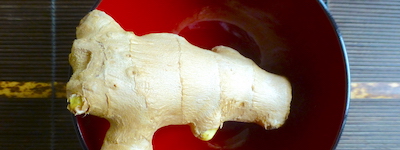If you’ve tried some Quick and Tasty recipes, you will have noticed that they never contain onion. There is no special reason for this other than that I prefer ginger. So let’s make the case for ginger.
Many people don’t like onion, raw or cooked. Also peeling and chopping onion is not pleasant, and the smell of onion is hard to wash off your hands. And yet most recipes contain onion. By contrast, few recipes contain fresh ginger. I argue that you don’t need onion to make tasty meals, and that you should consider using fresh ginger instead, and I present the Quick and Tasty recipes as evidence.
The main flavours cooked onion adds to a meal are sweetness and umami. But onion is actually not a particularly good source of umami. According to the web site of the Umami Information Center, onion contains about 20-50 mg glutamate/100 g. Ginger contains about 20 mg as well. For reference, tomatoes — a great source of umami — contain almost 250 mg glutamate/100 g. There are many other ingredients that provide umami.
Ginger has a unique fresh and very spicy taste, especially in raw form, but it does not burn the mouth like peppers. Raw ginger is great to spice up a salad. Frying reduces the spiciness and enhances the sweetness. The change in taste is the result of applying heat (which transforms gingerol into zingerone) so cooking in the microwave works fine as well, you don’t need to actually fry it.
Ginger has many proven health benefits, but the great taste is reason enough to start using it. Here are a few examples of Quick and Tasty recipes with ginger:
With raw ginger:
With cooked ginger:
- Simple winter hotpot with root vegetables and adzuki beans
- Potato and vegetable bake with cream cheese
With fried ginger:
Appendix: Ginger carbon footprint
Most fresh ginger in the UK is imported from China (somewhat surprising as India is the main producer), so you might be concerned about your ginger carbon footprint. I calculated that the contribution of the ginger to my carbon footprint is at most 0.01%.
- The CO2 footprint of shipping is 10 g per km per 1,000 kg of freight.
- The distance from China is 19,000 km.
- My ginger consumption is about 100 g per 2 weeks (7-10 g per meal), so about 2.5 kg per year.
So we have
10*19,000*2.5/1,000 =19*25 = 475
or about half a kilogram CO2 per year.
Using the WWF carbon footprint calculator, I estimate my carbon footprint to be 7-12 tons of CO2 per year. This means that my ginger consumption accounts for no more than 0.5/7,000 or 0.0071% of my yearly carbon footprint.
